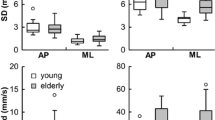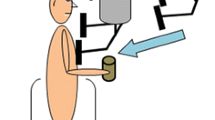Abstract
The position of the center of gravity (CG) is a reference value that is controlled by the nervous system during the performance of movements. In order to maintain equilibrium, leg movement is preceded by a shift of the CG towards the supporting side. This CG shift is initiated by an early displacement of the center of pressure (CP) towards the moving leg. This characteristic CP thrust partly results from the activity of a distal muscle in the leg to be moved: the gastrocnemius medialis (GM). The aim of this study was to determine how this weight-shifting is initiated when the distal muscles are missing, as in amputees, and to identify any change in the central command. Experiments were performed on ten subjects: five below-knee amputees with no pathology and five control subjects. While standing, the subjects were instructed to raise one leg laterally as fast as possible to an angle of 45° and to maintain the final position. The same weight-shifting strategy was used by both groups, whereas local adaptations associated with the behavior occurred. When the GM is lacking, an early tensor-fasciae-latae (TFL) burst is observed just prior to and associated with the onset of the lateral CP change. This moving-leg abductor may be responsible for initiating the thrust at a proximal level when that leg is still on the ground. In addition, upon analyzing the lateral displacement of the CP, two modes of CP shift were detected. The first CP-shift mode has been previously described and the second mode (which we term here the pre-pushing mode) was used by both amputees and controls. The pre-pushing mode consisted of two thrusts: an early thrust onto the ground was exerted by the leg about to become the supporting leg followed by the previously described thrust exerted by the leg about to be raised. The early thrust, which could be exerted by either the sound or prosthetic leg, may have increased the efficiency of the second, classical thrust by initiating a swing.
Similar content being viewed by others
Author information
Authors and Affiliations
Additional information
Received: 6 May 1997 / Accepted: 4 February 1998
Rights and permissions
About this article
Cite this article
Mouchnino, L., Mille, ML., Cincera, M. et al. Postural reorganization of weight-shifting in below-knee amputees during leg raising. Exp Brain Res 121, 205–214 (1998). https://doi.org/10.1007/s002210050453
Issue Date:
DOI: https://doi.org/10.1007/s002210050453




